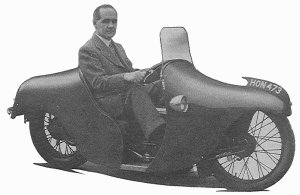Lawson Neracar, 1948
This is the Lawson Neracar made in the late 1940s. Compare and contrast its beautifully flowing home-made bodywork with that of the more boxy Avro Monocar made two decades earlier. There was a whole article about this machine in one of the weekly motorcycle magazines of the day, which was re-printed in Classic Mechanics in the 1980s. Most articles state that it was based on a Neracar chassis combined with a 4 cylinder in-line Blackburne engine. However, recent research (in 2019!) by Colin Ferguson has revealed that the four cylinder in-line OHC engine was actually made by John Haythorn. Colin writes: "It appears that John Haythorn was a Scottish automotive engineer, working with superchargers, who built the 288cc 4 cylinder OHC engine for Alec Lawson. He also built the Haythorn ( conventional ) bike with a 500cc 4 cylinder OHC Haythorn engine. Both one-offs apparently. It would appear that the Haythorn is in the Sammy Miller museum."
PNB




The Lawson Neracar.
Further research reveals that the " Haythorn " engine had already done at least 35,000 miles prior to being fitted to the Lawson Neracar in 1948. John Haythorn was born in Cathcart, Glasgow in 1904. He came from a family of engineers, who owned a brassfounders, and steam engine works in Pollokshaws Glasgow. He had built his own 0.67cc engine the size of a cigarette packet, while still at school. He also made his own spark plug for it!! He then made a 180cc horizontally opposed engine which he fitted to a bicycle. Not surprisingly, the bicycle frame soon failed, so he made up his own motorcycle frame and installed it in that. In 1933, he developed the 288cc 4 cylinder engine, and fitted it into his home made frame. This engine ended up in the Lawson Neracar. This was an OHC air / oil cooled engine, with a large car type oil pump which pumped large quantities of oil up to the head, returning to the sump by gravity. It had tappets adjusted by replacing shims in a bucket, much like the modern BMW K series engine. There were 4 screw in covers, which revealed the buckets for adjustment. In 1938, he made the 500cc version of this engine, and installed it in an OEC frame. This bike is in Sammy Miller's museum at New Milton, and has been restored by him. Called the " Haythorn " it really was ahead of it's time. It had no gearbox, but instead had cross shaft behind the engine with a clutch at each end. Then a drive chain either side of the bike to the back wheel. So, a two speed machine. Although not very flexible, John Haythorn had always intended to supercharge the 500cc engine, but fuel shortages, and lack of materials prevented that from happening. John Haythorn worked as an automotive engineer for Centric Superchargers in Preston, which later became the well known " Shorrocks " Superchargers. He was seconded to war duties in 1940, and nothing more is known about him until his death in Gourock, in Scotland in 1964. He married in 1937, but does not appear to have had any children. No one I have talked to has ever heard of John Haythorn. Just hoping that this article may well change that. BTW, it is assumed that the Lawson Neracar is no longer in existence. It seems criminal that such a landmark bike could be broken up or dismantled. I can only hope that one day someone may read this, and realise what they have got in their shed!
Colin Ferguson
Further information on John Haythorn
Further delving has revealed that John Haythorn's father had moved to Preston to work for the Atkinson brothers, who were engaged in repairing steam vehicles from around 1907. During WW1, they developed the Atkinson steam lorry, of which around 550 had been built by 1929. The Atkinsons had bought a small estate with a large mansion called Frenchwood House. They used the mansion as offices, and accommodation for themselves, and key employees. Hence, John Haythorn's address at one point was given as Frenchwood House. They built a factory in the grounds, and this is where the Atkinson steam truck was manufactured. Centric superchargers was actually started by the Shorrock brothers, Noel and Christopher, went bust in early 1939, and reformed as Shorrock Superchargers during WW2. As the name implies, they specialised in centrifugal superchargers, rather than the roots type vane blowers. Going back to Atkinson, the company was sold around 1930, and the new owners developed the Atkinson diesel truck which survived into the 1970's.